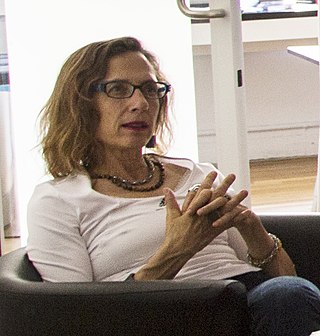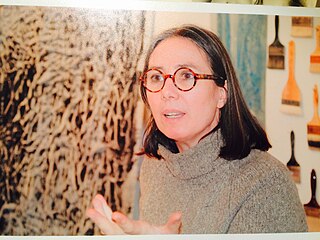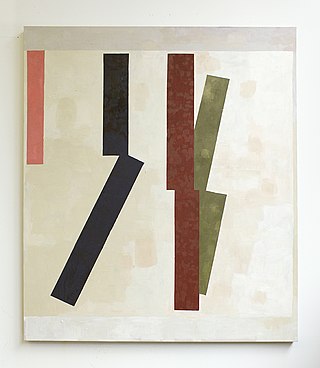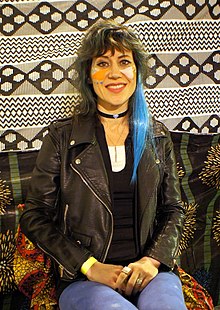
Hieronymus Bosch was a Dutch painter from Brabant. He is one of the most notable representatives of the Early Netherlandish painting school. His work, generally oil on oak wood, mainly contains fantastic illustrations of religious concepts and narratives. Within his lifetime his work was collected in the Netherlands, Austria, and Spain, and widely copied, especially his macabre and nightmarish depictions of hell.
Ena Swansea is an artist based in New York City. Her paintings often take memory as a point of departure.
Tomas Vu is an American artist whose primary media are painting, printmaking, and installation art. He is currently LeRoy Neiman Professor in Visual Arts at Columbia University.
Susan Silas is a visual artist working primarily in video, sculpture and photography. Her work, through self-portraiture, examines the meaning of embodiment, the index in representation, and the evolution of our understanding of the self. She is interested in the aging body, gender roles, the fragility of sentient being and the potential outcome of the creation of idealized selves through bio-technology and artificial intelligence.

Chitra Ganesh is a visual artist based in Brooklyn, New York. Ganesh's work across media includes: charcoal drawings, digital collages, films, web projects, photographs, and wall murals. Ganesh draws from mythology, literature, and popular culture to reveal feminist and queer narratives from the past and to imagine new visions of the future.

Cora Cohen was an American artist whose works include paintings, drawings, photographs, and altered x-rays. Cohen is most known for her abstract paintings and is often identified as continuing the tradition of American Abstraction. In a 2023 review in Artforum Barry Schwabsky suggested that "Cohen’s determination to evade stylistic consistency has made her one of the most underrated painters in New York." The New York Times' critic Michael Brenson wrote of her 1984 exhibition, Portraits of Women: "The works are dense, brooding and yet elated. The turbulence of the paint not only looks but also feels like freedom." Cohen interviewed many other artists also associated with continuing the tradition of American Abstraction for Bomb Magazine including; Ralph Humphrey, Dona Nelson, Craig Fisher, Carl Ostendarp, and Joan Mitchell. Her work has also been identified with traditions of European abstraction, and specifically German abstraction, including the work of Wols, Sigmar Polke, Gerhard Richter. She began exhibiting in Germany in the early nineties and continued to show at some of its most prestigious institutions.

Sonya Rapoport was an American conceptual, feminist, and New media artist. She began her career as a painter, and later became best known for computer-mediated interactive installations and participatory web-based artworks.
Beryl Korot is an American visual artist. Her practice includes video installation, weaving, paper tapestries, digital embroidery, and drawings.

The Fall of the Rebel Angels is an oil-on-panel painting of 1562 by the Netherlandish Renaissance artist, Pieter Bruegel the Elder. The painting is 117cm x 162cm and is now in the Royal Museums of Fine Arts of Belgium in Brussels, Belgium. The Fall of Rebel Angels depicts Lucifer along with the other fallen angels that have been banished from heaven. Angels are falling from the sun in a stacked manner along with ungodly creatures that Bruegel created. This piece by Bruegel was previously thought to be by Hieronymus Bosch. Bruegel was influenced by a variety of artists such as Albrecht Dürer, Frans Floris I, and Hieronymus Bosch. He also got ideas for the creation of his creatures in his previous works.

Claudia Hart is an artist and associate professor in the Department of Film, Video, New Media, Animation at the School of the Art Institute of Chicago, Chicago, Illinois. She has been active as an artist, curator and critic since 1988. She creates virtual representations that take the form of 3D imagery integrated into photography, animated loops and multi-channel animation installations.

Kyle Staver is an artist who lives in New York City.
Edda Renouf is an American painter and printmaker. Renouf creates minimalist abstract paintings and drawings developed from her close attention to subtle properties of materials, such as the woven threads in linen canvas and the flax and cotton fibers of paper. Renouf often alters these supports by removing threads from the weave of a canvas, or in her drawings, creating lines by incising the paper.

Vicky Colombet is a French-born American visual Artist. She lives in New York and Paris.
Faith Holland is a new media artist based in New York City. Her work engages with deconstructing female sexualization in the digital space and incorporates sculpture, video, and photography.
Copper Giloth is a new media artist based in Amherst, Massachusetts. Giloth's work involves digital media, mobile art, virtual environments, animations, videos, painting, and installations, and have been influenced by elements of her life such as her parents. She, along with Darcy Gerbarg, helped organize art exhibitions that showed alongside the SIGGRAPH conference, marking the exhibitions as the first to be shown at the conference. Giloth has been described as "one of the leading exponents of computer art".

Sharon Butler is an American artist and arts writer. She is known for teasing out ideas about contemporary abstraction in her art and writing, particularly a style she called "new casualism" in a 2011 essay. Butler uses process as metaphor and has said in artist's talks that she is keenly interested in creating paintings as documentation of her life. In a 2014 review in the Washington Post, art critic Michael Sullivan wrote that Butler "creates sketchy, thinly painted washes that hover between representation and abstraction.Though boasting such mechanistic titles as 'Tower Vents' and 'Turbine Study,' Butler’s dreamlike renderings, which use tape to only suggest the roughest outlines of architectural forms, feel like bittersweet homages to urban decay." Critic Thomas Micchelli proposed that Butler's work shares "Rauschenberg’s dissolution of the barriers between painting and sculpture," particularly where the canvases are "stapled almost willy-nilly to the front of the stretcher bars, which are visible along the edges of some of the works."
Dan Levenson is a contemporary artist based in Los Angeles, California. He works in painting, sculpture, installation, performance and video.

Yung Jake is an American artist and rapper. His work often explores new mediums and technologies, and spans across painting, sculpture, digital and internet art, video, music, apps, and products. His first well known work was "Datamosh" (2011), which was shown at the Digital Salon of the Sundance Film Festival in 2013, and his most well known works are emoji portraits of celebrities. He has directed music videos, including "H.G.T.V." for Pusha T, and worked on television shows for Adult Swim. He frequently collaborates with artist and programmer Vince McKelvie.
Kelani Nichole is a technologist and curator of time-based media and digital art active in the United States and abroad. She is the founding director of Transfer Gallery. Nichole has organized online exhibitions and public programs and in venues in cities like Brooklyn, San Francisco, Los Angeles, Miami, and Mexico City, among others.










